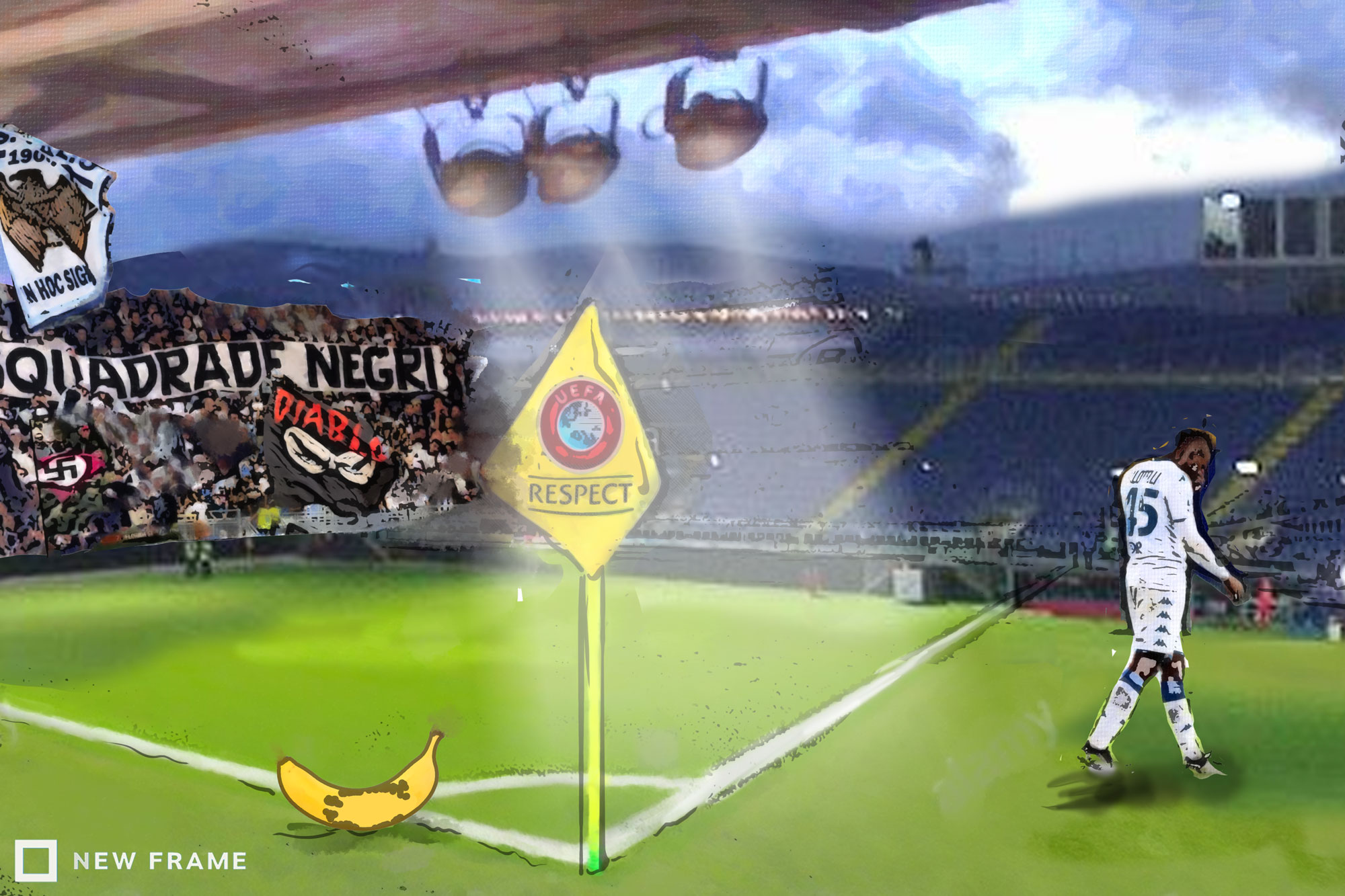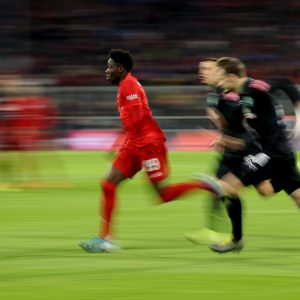Why Italian football remains racist
Italy’s Serie A league is not a hospitable place for black players, and the country’s football institutions doling out mere slaps on the wrist for racial abuse is leading to the spread of racism in…
Author:
20 March 2020

Italian football has gone from fighting one dangerous virus, whose ugly paws tarnished the beautiful game, to a more devastating virus that led to the suspension of football and forced the country to go under lockdown.
The European country has been the hardest hit by the coronavirus after China, where the epidemic started in Wuhan. But before Covid-19, as the virus is known formally, held the country hostage, Italy was struggling to deal with racism in football. A number of black players have been racially abused in Italian stadiums.
“I remember that when we were young, we also booed players with normal, white skin. Booing doesn’t always have a discriminatory connotation,” Lazio football club president Claudio Lotito said after the Italian football federation convened to discuss new measures to be taken to combat violence and racial discrimination.
Lotito’s words are quite revealing on why racism has been so rampant in the country’s stadiums. The lack of a unanimous recognition of the pandemic is rooted in Italian society and therefore also present in the institutions that should fight racism. Not recognising a problem inevitably leads to its trivialisation.
Italian National Olympic Committee president Giovanni Malagò compared racism to simulation in the penalty area: “It is wrong if someone boos black footballers, but it is even more wrong when someone who earns €3 million drops into the area and is also happy to gain a penalty.”
Related article:
Racism is a multifaceted virus, capable of continually renewing itself and producing solid antibodies. In the past five years in Italy, as well as throughout Europe, the rise of white supremacy and the increase in xenophobic and exclusive politics dominating the discourse have fuelled the spread of racism. They are allies who have found fertile ground among the rubble of a precarious socioeconomic fabric.
Such politics have slowly crumbled the fragile building of community. There were 58 cases of racial discrimination from 1 August 2019 to 1 March 2020 that affected Italian football and sport in general, according to Cronache di ordinario razzismo (Chronicles of ordinary racism), a website that has been keeping track of institutional and everyday racism in Italy since 2011. And the Observatory for Security against Discriminatory Acts (Oscad), Italy’s multi-agency body that tackles hate crimes, registered 969 racist crimes in 2019. That means one such crime every nine hours, as reported by il manifesto, an Italian newspaper based in Rome.
An Italian pandemic
“The current situation is very bad regarding equality rights. And it is not only the government’s fault, but also individual citizens bear their responsibility. The idea of collaborating to improve the world has collapsed somewhat. There is no common horizon for those who fight against discrimination. The situation will get worse and worse, until there is a serious response, accompanied by a long-term vision,” said the head of international politics Carlo Balestri at the Italian Union of Sports for All (UISP).
The UISP is a union that raises awareness about discrimination in Italian sport. Its goal is to reduce and limit discrimination; perhaps the UISP is aware it is not able to eradicate it entirely.
Sociologist Mauro Valeri, after systematically collecting data on racism in Italian football, created the Observatory on Racism and Antiracism in Football in 2005. It was a promising tool, but institutions and legal systems didn’t support it. The project was shut down when Valeri passed away in 2019 because he was the only one in charge of it. Balestri said Valeri’s death had left an unbridgeable void, but that he had nonetheless shown the path to follow: to be eradicated, racism must be studied and deconstructed because it is essentially the result of ignorance.
Related article:
And it takes time to achieve this, as it took time to instil in people a set of prejudices and creative scientific theories that transformed racism into something natural for some. This is true even for people who belong to those who suffer from racism, as shown by the Lecce football club coach’s reaction to the incident of racism during the match between Hellas Verona and Brescia.
In that game, on 5 November 2019, the professional footballer Mario Balotelli threw the ball towards Verona’s ultras, who were taunting him with racist insults.
“I also have black skin, but I never received any ‘buu’. Racism must not be exploited, and education is needed in the field,” Fabio Liverani said. Basically, the Italian-Somali coach, who was the first black person to make his debut in the Italian senior national team, said that racial discrimination is linked to the players’ behaviour on the field and justifies it in the event that the behaviour is negative.
It’s a serious stand that underlines how far Italy is from a correct interpretation of racism. It was 1992 when Lazio midfielder Aron Winter, black and Jewish, was met with despicable references to Nazism in graffiti and on banners. Since then, little has changed. Because little has been done to trace the origins of the virus of racism and deal with it.
Related article:
In the 19th century, after the unification of Italy and at the time of the first huge migrations to the Americas, the Nordic racists, who were an integral part of society in the United States, considered Italians to be second-class white people or “not clearly n*****s”. This was because of the olive colour of their skin, owing to a multiracial past.
For this reason, they discriminated against Italians. Then, it was a serious blow for Italians, who were experiencing an identity crisis, suspended between the belief that they were pure white people and the impossibility of being able to prove it. It was in 1890, with the establishment of the Eritrean colony in East Africa, that Italians first came into contact with a black population and experienced a racial and racist opposition.
A racially charged history
Their defeat in Adowa in 1896, during an attempt to expand into Ethiopia, exacerbated the crisis, which hasn’t been adequately tackled in the following centuries. Balotelli, on 10 August 2010, reopened the “ghost of Adowa” wound. The Brescia striker’s debut in the national team forced Italy to take a look at itself in the mirror and confront an issue that had been hidden under the carpet for too long: the country’s constantly evolving, multiracial society. It’s a confrontation that, despite calls in the national team from other black players for resolution, has often proved to be a facade.
The black Italian population is still considered foreign in society. There is no dialogue with black people. Italy has no desire to know them. There is an invisible, subtle form of segregation.
Related article:
“The system formally includes you, but practically excludes you,” said Balestri. In an embittered tone, he adds that “when you interface with institutions, you perceive everything is about political strategy. You don’t feel alone, but powerless.”
The Italian football federation and Lega Calcio football league are the football institutions in the country. The UISP partnered with the Lega Calcio to create Calciastorie, a project involving around 1 300 students in schools throughout Italy that aimed to highlight the human point of view and the personal history of the footballer in relation to discrimination levelled against him. Other than Calciastorie, which only lasted a year, Italy’s football institutions have continually conducted unconvincing anti-racism campaigns.
Institutional failure
They have failed to call on those who suffer discrimination first-hand. Had they done so, they could have avoided campaigns with ambiguous messages, and the Italian football federation’s triptych of monkeys painted by artist Simone Fugazzotto would not have caused such a stir around the world.
Lega Calcio made a first attempt to change the status quo by recruiting Omar Daffe, an Italian-Senegalese fifth-division goalkeeper. Daffe found himself the focus of the news after leaving the pitch, followed by his teammates, after being racially abused by spectators. That prompted Lega Calcio to put him under contract to study more effective anti-racism campaigns. In January, the Lega press office revealed that “in March we should be ready with a new programme of activities”.
The new Observatory on Discriminatory Violence in Sport was supposed to launch on 21 March, the International Day for the Elimination of Racial Discrimination. It was meant to focus especially on amateur sport, which “even without ending up on the front page, represents the most widespread and least explored aspect of the phenomenon”, according to Italy’s National Office against Racial Discrimination.
Related article:
The launch is on hold because of the outbreak of Covid-19. But will this new observatory be enough?
“We need to work on two fronts,” said Balestri. “Talking to young people in schools and sports clubs, and educating role-model players to ensure that they convey positive values. Then you have to put the clubs on the ropes, to make them feel the social responsibility that they don’t feel today.
“Hope is always there,” concluded Balestri. “It comes from small acts and small battles we gained. The war may never be won, but we fight to make sure that there is never a real defeat.”





